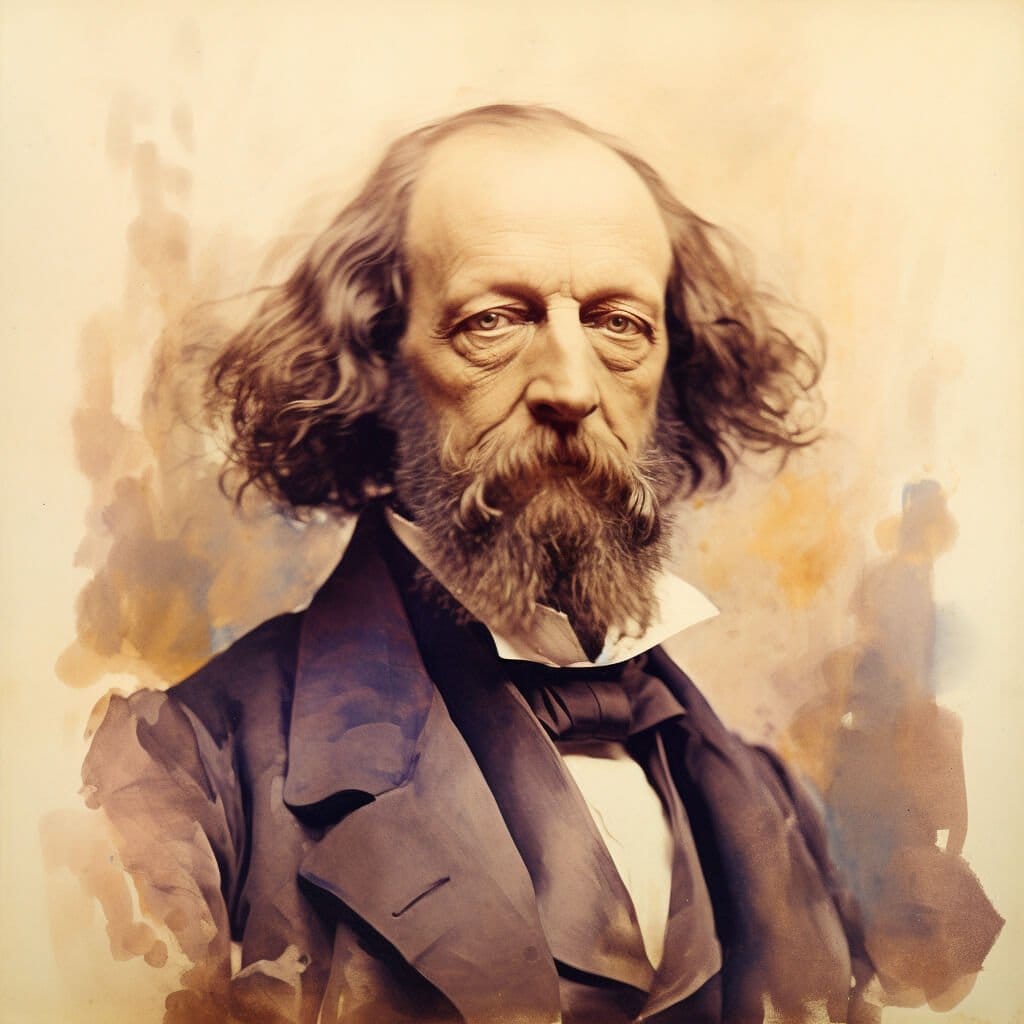Alfred Lord Tennyson is one of the most popular poets of the Victorian Era in England. He was named the UK Poet Laureate after William Wordsworth and served in the position for forty-two years. He is remembered for his sober style and moralizing tone. Two of his best-known poems are ‘In Memoriam A.H.H’ and ‘The Charge of the Light Brigade.
Many scholars believe that it was the death of his close friend Arthur Hallam and the struggles he had to go through as a young man during that time that inspired him to write some of his most famous lines of poetry. This experience of grief and having to overcome despair bled into his works, making them timeless and adding soul, captivating not only Victorian poetry lovers but modern readers alike.
Tennyson also held high standing in Victorian society, having the title of ‘1st Baron Tennyson of Aldworth and Freshwater’.
Tennyson’s crowning achievement, and the pinnacle of fame, was becoming the poetic representative for the reign of Queen Victoria, not only becoming Poet Laureate but was buried in Poet’s Corner at Westminster Abbey, a spot only reserved for the greatest poets of a generation.

I hold it true, whate’er befall; I feel it, when I sorrow most; ‘Tis better to have loved and lost Than never to have loved at all.
Alfred Lord Tennyson Quote
Life Facts
- Alfred Lord Tennyson was born in August 1809 in Somersby, Lincolnshire, England.
- Tennyson published his masterpiece, ‘In Memoriam A.H.H.‘ in 1850.
- He was named Poet Laureate after William Wordsworth.
- Alfred Tennyson died at the age of 83 in October of 1892.
- His body was interred at Westminster Abbey.
Interesting Facts
- Tennyson met his friend, Arthur Hallam, at Trinity College, Cambridge.
- His books of verse published in the early 1830s were met with poor reviews.
- Tennyson’s book ‘Poems‘ was a success, published in 1842.
- In 1884 he was named Baron Tennyson, the first person to be raised to a British peerage due to his poetic works.
- Tennyson was still writing when he was in his 80s.
Famous Poems
- ‘Tears, Idle Tears‘ was published in 1847 and is one of several poems that’s taken from The Princess. The speaker is a court maiden who sings an emotional song about summer, birds, love, life, and death. She presents the listener with a series of images that bring endless tears.
- ‘The Lady of Shalott’ is a well-studied and commonly read poem that was published in 1833. It is loosely based on the Arthurian legend of a woman who dies of unrequited love. Tennyson changes the basis of the story around slightly, rethinking it so that the main character is suffering from a curse. She’s doomed only to see the world through a mirror. If she turns around and sees it for herself, then she’ll die.
- ‘The Lotos-eaters’ is another of Tennyson’s most popular poems and is based on mythology. Specifically, Tennyson was inspired by Homer’s Odyssey and the story of Odysseus’ men stumbling upon the land of the lotus-eaters and eating lots themselves. The first part of the poem describes the story of the men and their newfound desire to stay where they are forever, never to return home. The second part is the “Choric Song.”
- ‘Tithonus’ was first published in 1833 with the title ‘Tithon.’ The poem is characteristic of Tennyson’s style. It uses the story of Tithonus, a character from Greek mythology, to speak on the inevitability of death. The story describes Tithonus, who wishes for eternal life, and how that wish backfires. He lives forever, but he also continues to age.
- ‘In Memoriam A.H.H.’ is a long poem published in 1850 and dedicated to the life and loss of Arthur Henry Hallam, one of Tennyson’s closest friends. He was only twenty-two years old when he died, and his loss had an enormous impact on the poet. The poem is 131 sections long, with both a prologue and epilogue that speak on a variety of topics connected to life, death, love, and friendship.
Explore more Alfred Lord Tennyson poems here.
Early Life
Alfred Lord Tennyson was born in August of 1809 in Somersby, Lincolnshire, England. Tennyson’s father was a deeply religious man and worked as a rector of Somersby, Benniworth, and Bag Enderby, as well as the vicar of Grimsby. He was said to be a wise and well-intentioned man who was able to support his family’s solidly middle-class lifestyle successfully.
Tennyson was one of twelve children and, along with two of his brother, was engaged with poetry from a young age. Although Tennyson’s brothers were talented poets, it was Alfred that reached the pinnacle of poetry. One of his brothers was housed in an insane asylum for the majority of his life, whilst two struggled with addiction and alcoholism. By the age of twelve, Tennyson had written his first epic poem, which consisted of 6,000 lines, and by the time he was seventeen, he and his brothers had a collection of poetry published.
From 1816 to 1820, Tennyson attended Kind Edward VI Grammar School and then left his home to attend Trinity College, Cambridge, in 1827. It was there that he and his brother Charles co-published a book of poems titled, Poems by Two Brothers. This book put Tennyson on the radar of other prolific college writers, and he made friends with another student, Arthur Hallam. After a brief but intense friendship, Hallam died, leaving a bereft Tennyson to devote a number of poems to his memory.
During their friendship, they worked closely together and became members of a secret society called the Apostles, a group of Cambridge undergraduates that were regarded as the most talented and gifted writers across the entirety of the university.
Literary Career
From 1830 to 1833, Alfred Tennyson’s poetry came in two collections. These were not met with outstanding reviews, a fact which greatly disappointed him. His naturally shy disposition would keep him from publishing again for another nine years. Tennyson finally met with some success in 1842 after the publication of his book, Poems, in two volumes.
It was in 1850 that Tennyson reached the peak of his career. He published what is considered to be his masterpiece, In Memoriam A.H.H. This piece, inspired by Hallam’s death, solidified his reputation and future career and led to his naming as Poet Laureate by Prime Minister William Gladstone, following directly behind William Wordsworth. He would hold this position until his death. After their engagement that same year, he married Emily Sellwood, with whom he would have two sons.
Tennyson’s love for his friend Arthur Hallam was heavily embedded in his works. Not only did he write the excellent ‘In Memoriam A.H.H,’ but he penned the work ‘Morte d’Arthur,’ in which the main character was King Arthur. However, many poetry lovers believe Hallam was the real inspiration behind the work.
Some of his other poems that were considered poetic masterpieces were:
- ‘The Lady of Shalott‘
- ‘The Palace of Art‘
- ‘A Dream of Fair Women‘
- ‘The Hesperides‘
- ‘Oenone‘
- ‘The Lotos-Eaters‘
- ‘Marian in the South‘
- ‘Maud‘
- ‘Idylls of the King‘
Death
Tennyson’s popularity and success allowed him to continue writing full-time and purchase a home for his family in the country. In 1884 he was named Baron Tennyson, the first person to be raised to a British peerage due to his poetic works. Tennyson continued to write into his 80s and died at the age of 83 in October of 1892. His body was interred at Westminster Abby, and to this day, he remains one of the most popular Victorian poets.
Influence from other Poets
Alfred Tennyson was notably influenced by writers such as John Keats, Percy Bysshe Shelley, William Shakespeare, William Wordsworth, and Edmund Spenser.
FAQs
Despite creating a large collection of critically acclaimed poems, many consider the most famous poem written by Alfred Lord Tennyson to be ‘The Charge of the Light Brigade,’ which was released in 1854. It tells the story of a group of soldiers fighting during the Crimean War.
Alfred Lord Tennyson was born in Somersby, Lincolnshire, on 6th August 1809 to Elizabeth Fytche and George Clayton Tennyson.
Alfred Lord Tennyson explores the theme of war in his famous poem ‘The Charge of the Light Brigade,’ a narrative poem that tells the story of a group of soldiers and the impact war has on them. He calls for the reader to honor their heroic efforts, and this translates to all wars throughout history.
Alfred Lord Tennyson uses nature in his poems to see the backdrop both physically and emotionally. He also uses it as an aid to help bring the reader into the emotions and feelings of the poem. We see this in his work ‘The Lotos-Eaters,’ where the use of nature enhances the feeling of inertia and fatigue.
Due to his critical acclaim and position as the UK Poet Laureate, Alfred Lord Tennyson’s body was brought to Westminster Abbey and buried in Poet’s Corner, a highly prestigious burial place allocated only for the greatest poets in British history.


